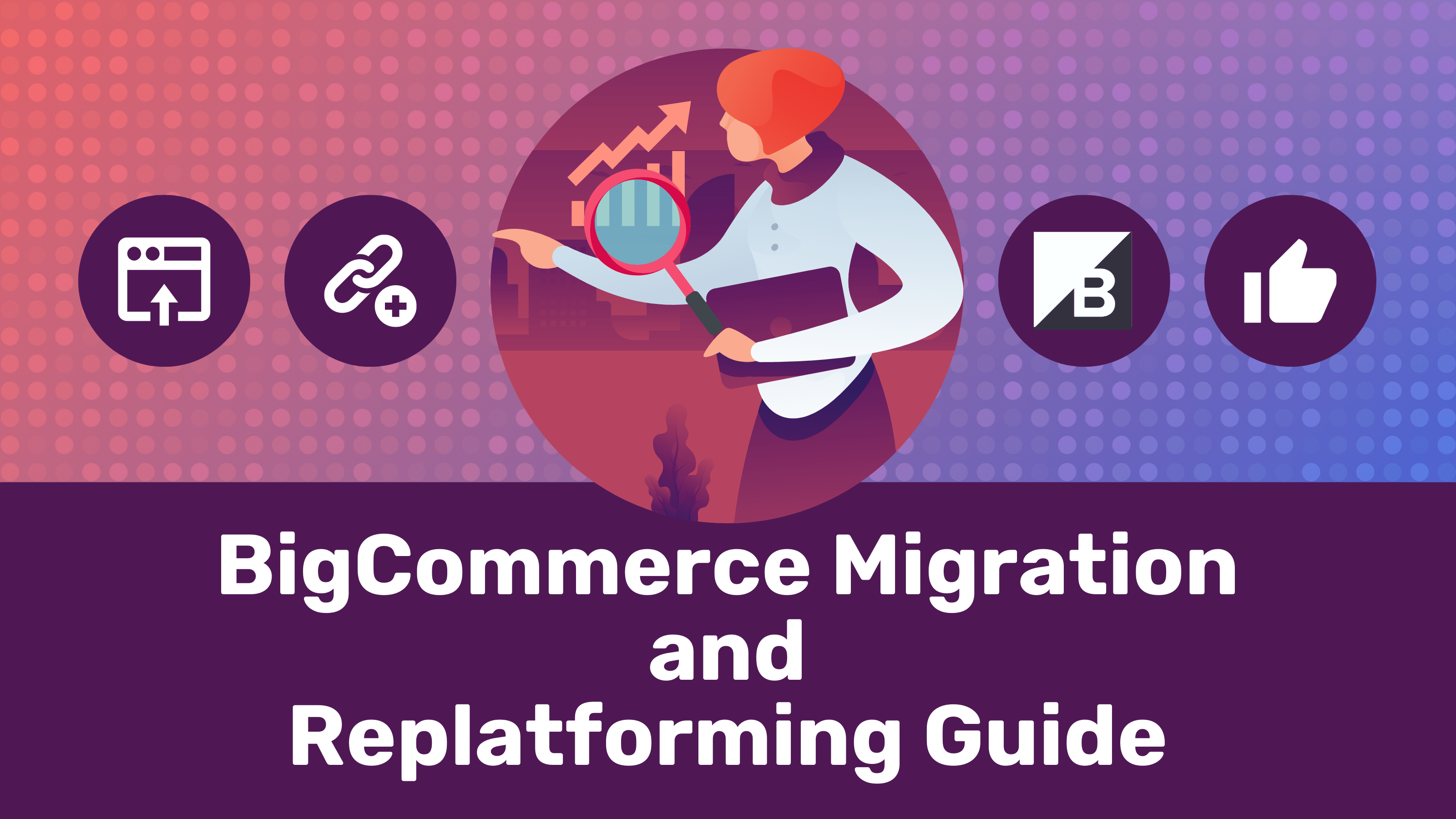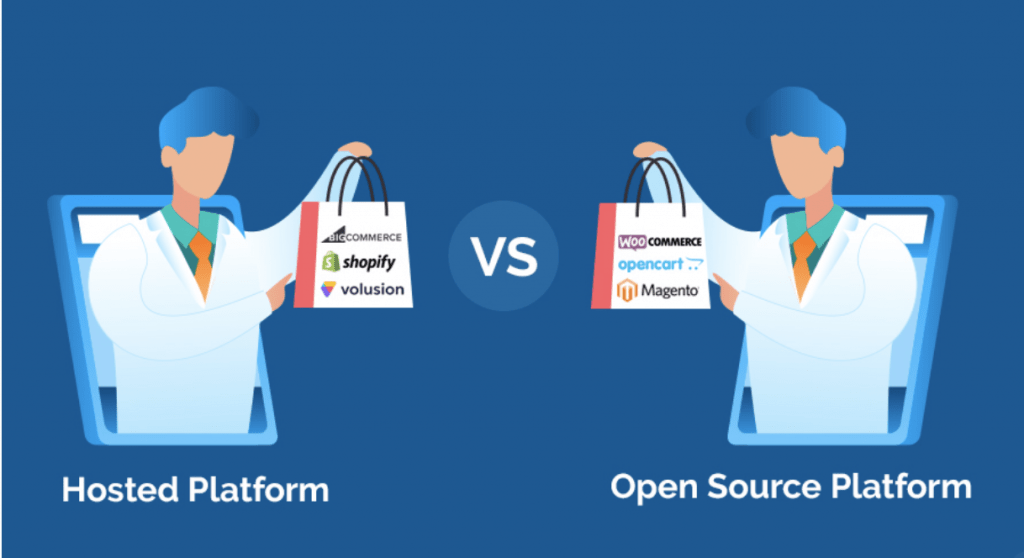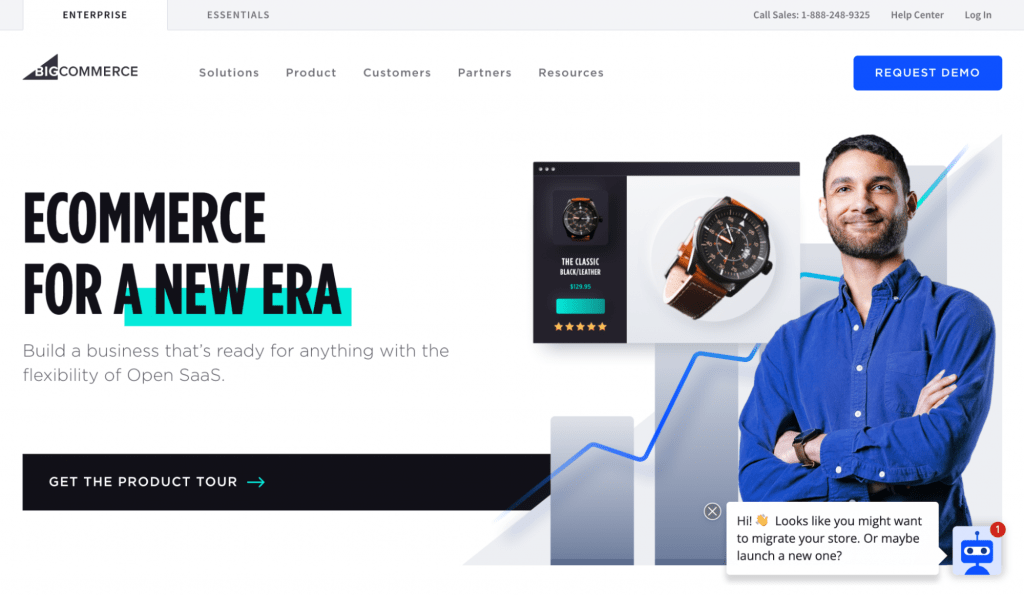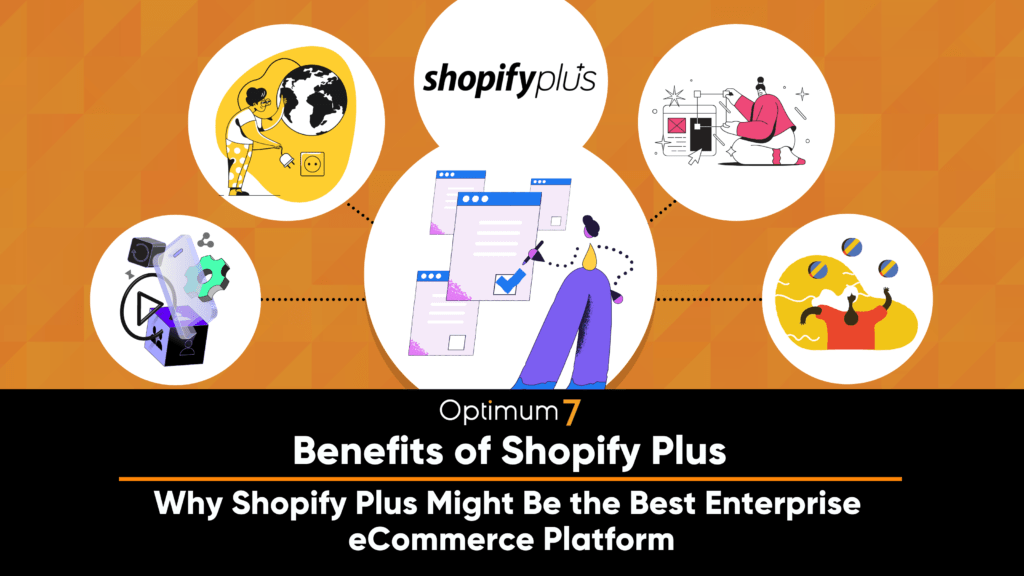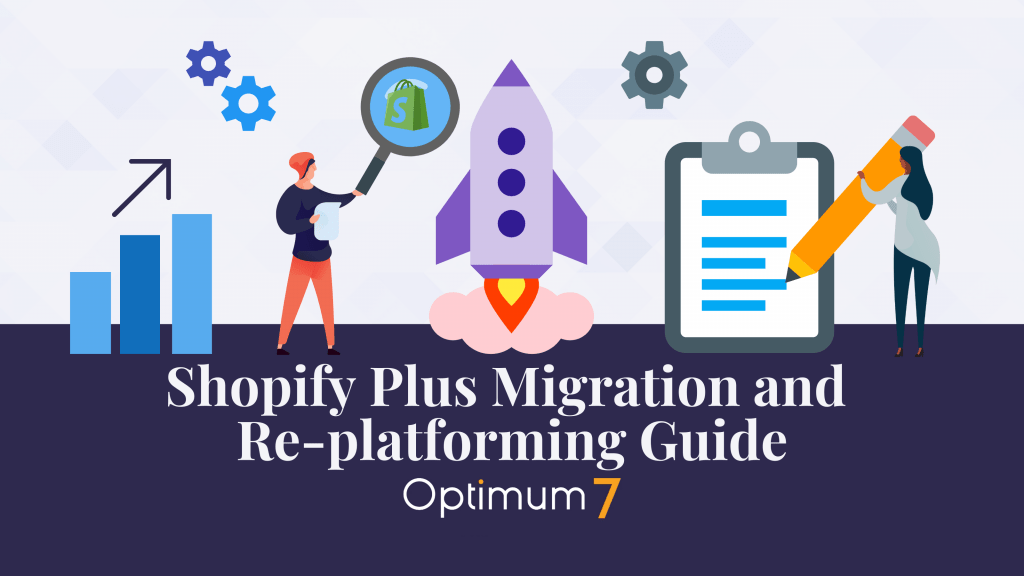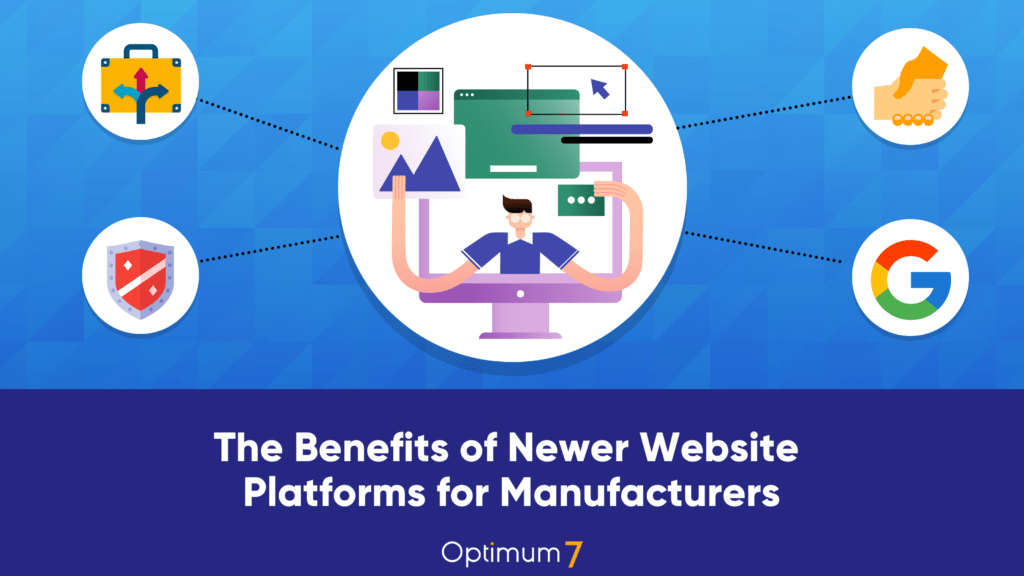If you’re thinking of moving your eCommerce site to BigCommerce, this guide is for you. This is a detailed guide and checklist on how to migrate your eCommerce platform to Bigcommerce.
Replatforming your eCommerce site is a big step. But it’s often necessary if you want to scale, make custom changes, or fix problems with your existing eCommerce solution.
Throughout my career, I’ve assisted with thousands of eCommerce migrations for sites of all shapes and sizes. A significant portion of those migrations was for online stores moving to BigCommerce.
Before you jump in and move forward with BigCommerce re-platforming, you need to read this guide. I’ll explain everything you need to know about the process, signs you need to migrate, the advantages of eCommerce migrations, risks associated with re-platforming, costs of re-platforming, and so much more. You’ll also learn more about the steps involved in a BigCommerce migration and the importance of finding the right BigCommerce Development agency to move your data.
What is an eCommerce Platform Migration?
In simple terms, an eCommerce migration moves your website data from one platform to another. eCommerce retailers typically move to new platforms as a way to improve the performance, customer experience, and functionality of the website.
So if you’re currently using an eCommerce platform to power your online store, and you want to move the site to BigCommerce without losing your data and traffic, you’d need to go through the re-platforming process.
Examples include:
- Volusion to BigCommerce
- Shopify to BigCommerce
- Magento to BigCommerce
- 3dcart to BigCommerce
- OpenCart to BigCommerce
- VTEX to BigCommerce
- Wix to BigCommerce
- WooCommerce to BigCommerce
- Miva to BigCommerce
- PrestaShop to BigCommerce
- Squarespace to BigCommerce
If you’re starting a new eCommerce site from scratch and don’t need to migrate any data from one platform to another, that’s not considered migration or re-platforming.
Understanding the Different Types of eCommerce Platforms
Before we dive into the specifics of a BigCommerce migration, I want you to have a firm grasp of the different eCommerce categories. There are lots of different eCommerce systems out there—each with its own pros and cons.
Generally speaking, we can segment all eCommerce platforms into three main categories:
- Open Source (WooCommerce, Magento, Xcart, PrestaShop)
- Hosted (Volusion, Shopify, BigCommerce)
- Enterprise (VTEX, Sitecore, SAP Commerce Cloud)
There’s also a DIY category that includes platforms like Wix or Squarespace. These are not true eCommerce systems. So if you’re currently using one of those options, you need to get out immediately. There’s no way to truly scale your online store this way.
So which category or platform is the best? There’s no single answer to this question. It all depends on the specific needs of you and your online store.
But for the most part, the best eCommerce platforms also have the best content management systems. You want to look for a solution that allows you to make day-to-day changes within the CMS without having to rely on an in-house developer for everything. BigCommerce falls into this category, which is why we recommend it to so many of our clients.
For mid-sized eCommerce operations, BigCommerce is a solid solution. Any eCommerce site that generates $5 million to $100 million per year can rely on BigCommerce.
Many online stores in the mid-size category may need features like advanced structures, B2B functionality, pre-checkout upsells, the ability to manage multiple warehouses in different locations, the ability to seamlessly work with a channel manager, and more. You can do this with BigCommerce.
Signs You Need an eCommerce Migration: When Should You Replatform to BigCommerce?
Here’s a question I hear almost every day—how do I know when it’s time to re-platform my eCommerce site and migrate my data to a new platform?
There’s no hard-and-fast rule for this question. Each situation is unique. With that said, there are definitely some common circumstances and signals that are usually a sign you need a new eCommerce system.
If you have an existing eCommerce site and you feel like you’re outgrowing the platform, that’s the number one sign that you need to switch. Many eCommerce systems are fine for your first $500,000, $1 million, or even $2 million in revenue. But you may start to experience limitations as your online store grows. Migrations and re-platforming can be a way to improve functionality, efficiency, and scale for your existing eCommerce store.
I’ll cover different scenarios below, then give my opinion on whether or not this situation calls for re-platforming to BigCommerce:
Scenario #1
You’re starting a new eCommerce store from scratch. You do not have an existing business, you don’t have a website, and you’ve never sold products (in person or online).
This is not a situation that calls for migration.
You can start by just testing a few products to see if you’ll actually make money. As a proof-of-concept site, before you scale, start a website on WordPress and WooCommerce for shopping cart functionality. You don’t need BigCommerce right now.
Scenario #2
You have an existing business that sells products in-person as a brick-and-mortar retailer. Now you want to expand and sell products online.
This is technically not an eCommerce migration, but it’s borderline. You still may want to migrate your product data and customer data from your retail solution to an eCommerce system. But again, you’re not switching from one eCommerce platform to another.
Scenario #3
You’re currently selling around five or ten products online. You’ve been selling products for a while and proved that there’s a demand for your inventory. The current system you’re using is generating good revenue, and you’re turning a profit.
In this situation, you should be using a hosted eCommerce solution like Shopify or BigCommerce.
Hosted solutions typically offer tiered pricing. So you can always start at an entry-level package and scale as you need. You can definitely use BigCommerce in this scenario.
Scenario #4
Your eCommerce website is generating $1 million per year and growing at a 200% annual rate. You want to make sure that you’re using the right system for scale. It feels like the current platform doesn’t have what you need to double or triple your revenue.
If you’re on a hosted solution like Shopify or BigCommerce, you could consider upgrading to one of their enterprise plans (Shopify Plus or BigCommerce Enterprise). Just be aware that your costs will also increase to $1,000 or $2,000+ per month at this level. While these aren’t full enterprise solutions, they’re close. You can comfortably scale to $10-$20+ million per year on these systems.
Maybe you’re on a hosted solution, but the platform just isn’t doing what you hoped it would. Many people using Volusion experience problems here. This would be a scenario that calls for a BigCommerce re-platforming and data migration.
Benefits and Advantages of BigCommerce Migration and Replatforming
Here are some of the top advantages of migrating your eCommerce data to BigCommerce:
- Ability to scale your online store
- Get your database structured properly
- Create proper parent-child relationships with your products
- Great way to clean house and get your database organized
- Improve the user experience and make it easier for customers to navigate the site
- Customization capabilities and improved functionality
- Overcoming the limitations, downtime, or bugs with your current eCommerce system
Custom eCommerce Migrations and Replatforming For BigCommerce
If you’re looking for something completely customized, without the complexities of a true enterprise-level system, BigCommerce is an ideal solution.
You could also consider Shopify or Magento. But with a system like Magento, you’d need a partner or someone in-house to handle the technical maintenance of this site. But since BigCommerce has such a user-friendly CMS, you don’t need to rely on a developer for daily maintenance.
Look for plugins or extensions to customize the eCommerce system through the platform’s marketplace. There are some good options out there for basic stuff, but if you need something unique, you’ll find these options a bit limited. If you use Optimum7 to migrate your eCommerce site to BigCommerce, we can also build custom eCommerce functionality for your online store as well.
For example, maybe your current eCommerce platform isn’t good with abandoned carts or upsells. You could look for an extension or build something custom to address this need.
Risks of a BigCommerce Data Migration and Replatforming
Many eCommerce owners are scared to migrate their data and move to a new platform.
The biggest risk associated with this process is data loss. You need to make sure that the data is structured properly, so all of the orders, product images, reviews, and every aspect of your database get migrated properly and stored in BigCommerce.
There can be issues with field mapping during a migration. For example, Volusion has different database fields and different special characters than BigCommerce. Product options are handled differently from platform to platform.
To keep things simple, here’s the data you need to migrate:
- Products
- Customers
- Product Options
- Orders
- Functionality
An example of functionality would be an age verification function for an eCommerce website that sells vaping products.
Loss of traffic is another risk associated with eCommerce migrations. That’s why it’s so important to have proper 301 redirects, as these are crucial for SEO purposes.
Every platform has a unique way of structuring URLs. All of the URLs on your website right now are on your existing platform. They’ve already been indexed on Google and linked to your site through backlinks. Even your product URLs and category URLs are going to change when you migrate. Now we have to make sure those URLs seamlessly redirect to BigCommerce.
If this isn’t handled properly, you’re going to lose a lot of traffic. You might even get flagged by Google for too many bounces and 404 errors. You don’t want to lose all of the link juice and domain authority you’ve been building over the years. 301 redirects will fix this for you.
Costs of BigCommerce Migration and Replatforming: Is it Worth the Price?
Many eCommerce sites have already invested a lot of money into an open-source solution. In some cases, they’ve invested over $500,000 or even $1+ million.
Based on this large investment, they feel like they cannot switch to a new platform. The owners and stakeholders feel like they’re committed to the existing solution.
But there are lots of problems with this logic. You can’t grow if you need to continue pouring money into a broken system for the long run. I’m sure you don’t want to continue losing money and experience frustrations on your existing platform. So just migrate and be done with it.
The migration process could cost you anywhere from $100,000 to $100,000. But it’s well worth the investment.
You’ll be set up on a proper eCommerce system that can handle your needs for the long term. This will be sustainable for your business in the years to come.
There will be a handful of painful days in the short term as you’re moving away from something you’ve invested in. But if your platform has poor support or long downtime, then you need to move on. This is something that’s really common with Volusion. The platform has gone downhill in recent years. The CMS is basically non-existent, and there are so many limitations for development, operations, and marketing. If you’re currently using Volusion, it’s definitely worth the switch to BigCommerce. You’ll want to partner with an agency that offers professional BigCommerce development services.
BigCommerce Data Migration Myths Debunked
There’s lots of misinformation out there about eCommerce re-platforming. I just want to quickly debunk the most common myths, to help give you peace of mind about your decision:
Myth #1 — Loss of Sales
Your store won’t be offline during the transfer process. So you don’t have to worry about losing sales due to downtime.
While your new store is being built, tested, and customized, your existing store will still be live on your current system. So your customers can still shop online without any problems.
Myth #2 — Design Problems
Lots of eCommerce owners have fallen in love with their existing designs. But they’re worried this design will be gone when they move to BigCommerce.
Fortunately, BigCommerce has open template files. This means that you can bring any custom design elements from your old platform to your new BigCommerce store.
Myth #3 — Lost Traffic
As mentioned earlier, traffic loss is only a problem if you’re not doing 301 redirects the right way.
But if you’re migrating with a trusted partner who can handle this for you, all of your domain authority and link juice from your old eCommerce platform will come with you to BigCommerce. So you won’t have to worry about a drop in traffic or SEO problems.
Myth #4 — Cloning Your Store
Replatforming to BigCommerce is not an exact clone of your store. It’s simply the process of transferring your existing eCommerce data from one platform to another one.
You might have to go through some small changes. But BigCommerce can handle whatever you need. For example, BigCommerce seamlessly integrates with dozens of payment gateways. The platform also has an open and unrestricted API that you won’t find on other eCommerce platforms.
Myth #5 — You Can Do it Alone
Migrating your eCommerce site to a new platform is a daunting task. Don’t attempt this on your own. Even if you have an in-house team of developers that feels like they have the technical skills to handle this process, you should leave re-platforming to the professionals.
Here at Optimum7, we’ve done thousands of eCommerce migrations. So we know exactly how this process works and what to expect along the way. You wouldn’t want to trust something so important to a developer who’s only attempted this once or twice.
How to Migrate to BigCommerce
Again, you shouldn’t be doing this on your own. But I just want to give you a simple overview of what the BigCommerce migration process looks like:
- Make Sure Replatforming is Right For You: The first thing you need to do is determine whether or not you fall into a scenario that calls for an eCommerce migration. You can use the examples that I discussed earlier in this guide as a reference.
- Verify BigCommerce is Right For Your Business: Next, you need to make sure that BigCommerce fits the needs of your online store. If you’re only selling a handful of products and doing a modest $20,000 in revenue per year, you’re probably fine on the platform you’re using right now. Look at a BigCommerce migration when you’re ready to start generating $5+ million annually.
- Gather all of Your Data and Shopping Cart Details: Get yourself organized. Look at your databases and clean things up. This could be a long process, depending on how messy your existing database is.
- Choose the Data You Want to Transfer: Now you need to narrow down the data that’s going to come with you to BigCommerce. To keep it simple, focus on your products, customers, product options, orders, and functionality.
- Migrate and Replatform to BigCommerce: Once all of this is in place, you’ll be ready to move your site from its existing platform to BigCommerce.
The re-platforming process is far less intimidating when you break it down into these five simple steps.
Final Thoughts — Choosing the Right Partner to Help With Your BigCommerce Migration and Replatforming
Here at Optimum7, we’ve seamlessly executed thousands of eCommerce migrations. We’re a trusted BigCommerce partner and know how to migrate data from any eCommerce system to BigCommerce.
Don’t attempt this on your own.
As mentioned earlier, there are lots of risks associated with an eCommerce migration. Too many things can go wrong if you don’t have the knowledge and technical experience to move the data, handle redirects, and manage all of the other complexities associated with this process.
Learn more about our eCommerce migration services here. You can speak to an expert and request a free quote for your BigCommerce migration.



